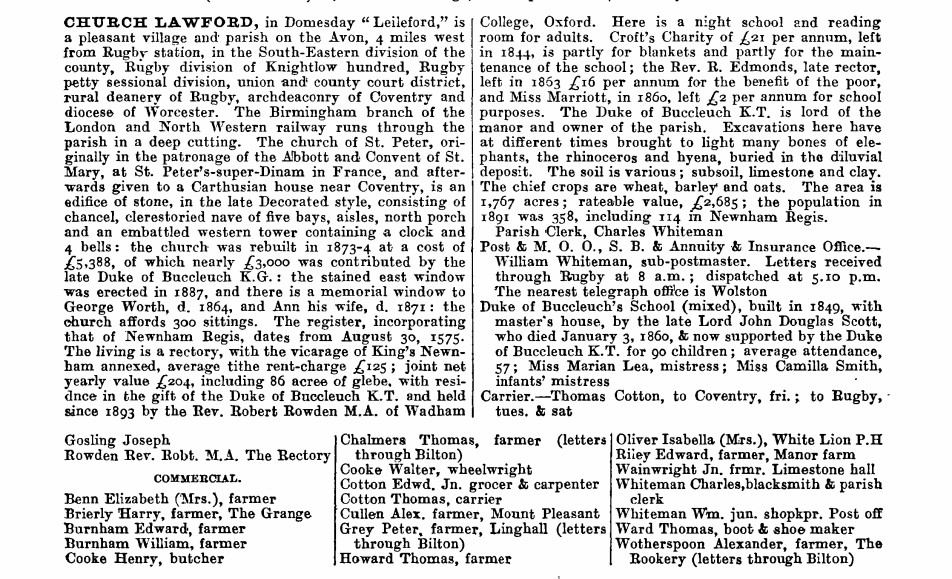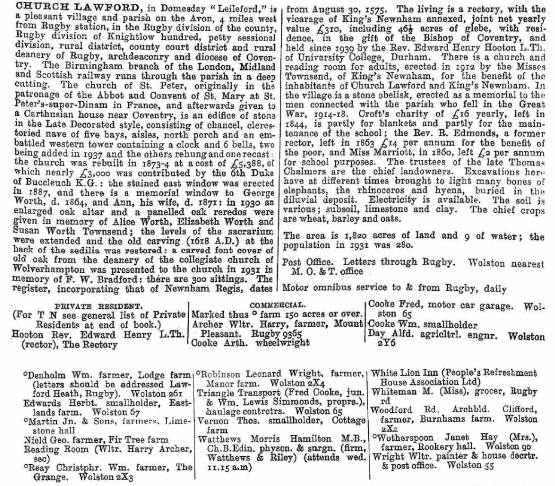The story of improved communication between the two villages and the outside world should perhaps focus on the various changes during the 20th century, but perhaps the changes started in the previous century, although rural areas clearly had to wait for new facilities to reach them.
During the 19th century the Mail service had been much improved, both in terms of cost and coverage. The growth of the mail system during the second half of the century was significant, and it brought with it a significant increase in the number of post offices – and a ripple effect meant that the service in more rural areas also improved. Church Lawford saw its first permanent Post Office by around 1880, with letters received in the village in the morning, and sent to Rugby at around 5pm – as shown below.

Another innovation during the 19th Century was the Telegraph service, which allowed messages to be transmitted point-to-point via pulses on dedicated telegraph wires. This service began in big cities, and began to filter down to the regions, but with the need for dedicated wires and trained operators as well as the costs and limitations of the service it was not as pervasive as the mail system – or indeed as the telephone system would be. It was good for spreading news quickly, whether between press agencies or getting urgent person to person messages through via the Telegram service. As can be seen above, the service had reached Wolston by the end of the century, but the two villages did not have their own service. The local Telegraph office for King’s Newnham was at Brinklow.
Voice telephony had begun some years earlier in various cities, and was reaching out into rural areas after the Great War. Telephone services came to Church Lawford and King’s Newnham in the late 1920s. There is a record for a phone connection to Manor Farm in Church Lawford and Newnham Hall in King’s Newnham from as early as 1927. Some Post Offices offered a service that allowed voice calls to be made by the general public – for example such a service was offered at Wolston, but the suggestion is that may not have been available at the Church Lawford Post Office.
The first telephones were manually operated as they pre-dated the electricity supply reaching the village, and their connection was to the local exchange in Wolston. The first users were local farmers and tradespeople. Once the Post Office had a telephone service it was able to simplify the link with the Wolston exchange and relay telegrams. By the early 1930s there was a phone kiosk on the green – for more details see here.
The initial telephone numbers were two digits – the Triangle Garage was 65, or two digits plus a letter – e.g. 2y6 for Alf Day Blacksmith, or 2×3 for Grange Farm. These numbers were maintained until the start of the Second World War, as seen in the 1940 Kelly’s directory below

The equivalent directory entry for King’s Newnham does not list numbers, although it is known that various residences were connected by 1940.
After the Second World War the numbering system was revised to be three digits. Triangle Garage was now Wolston 265, Alf Day had the number Wolston 248, and Grange Farm was 249.
By the late 1960s various changes were needed to increase capacity, and a four digit system was introduced. One or two subscribers were allocated a similar number, but many were changed. Triangle Garage was now Wolston 2265, Alf Day had the number Wolston 2484 but Grange Farm changed to 2133.
In 1979 more change was required, and this time two extra digits (54) were added to the start of the numbers. This meant Triangle Garage was now Wolston 542265. The STD system was now complete, allowing direct dialling nationwide. Users were still expected to look up dialling codes for the exchange they wished to dial.
By the mid to late 1980s the STD prefix 0203 for the Wolston Exchange was listed rather than the exchange name itself.
The move to 16th April 1995 saw the transition to eleven digits STD codes on what was known as PHONEday (sic). All codes that were previously starting 0203 now started 01203.
More system updates meant a further change in April 2000 when the STD prefix changed from 01203 to 024 76.
